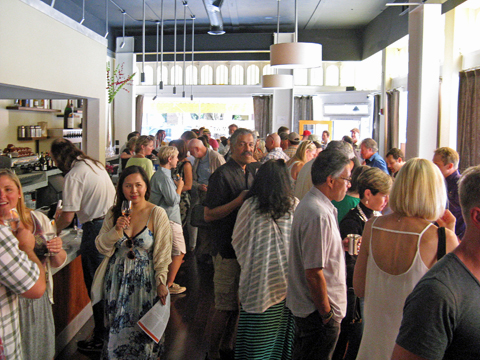Bailiwick Wines
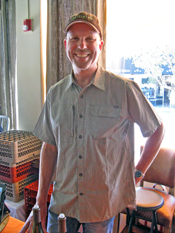 |
Bailiwick 2010 Pinot Noir, “Borderline,” Marin County. From 115 and 777 clones from Kendric Vineyard, aged in 50% new French oak. Medium-light color, with raspberry and black cherry fruit, spice, and hints of chocolate and sweet oak. Medium-bodied with a moderately rich texture, this finished with refined tannins.
Bailiwick 2011 “Borderline” Pinot Noir, Marin County. From 667 clone from Chileno Valley and 777 from Kendric vineyards, about 20% whole cluster with a 28-day maceration, and aged in 36% new French oak. Slightly lighter color than the 2010, featuring bright red cherry aromas along with citrus, herbs, and earth. Medium-light bodied, with a lively mouthfeel and fine tannins, nice.
Bailiwick 2012 “Borderline” Pinot Noir, Marin County. To be released this fall, from about 50% each Chileno Valley and Kendric Vineyards. Medium-light color, this showed black cherry and lots of spice on the nose, along with touches of earth and oak. Medium weight on the palate with good structure and bright acidity, finishing with firm tannins – needs time but shows good potential.
Comments: Bailiwick is the label of brothers Bryan and Paul Vais, and their first releases were from the 2009 vintage. They also make several nice Pinots from other appellations, and produce Vermentino and Cabernet Franc as well. Bailiwick’s “Borderline” Marin Pinots have been standouts from the start.
Brooks Note Winery
 |
Brooks Note 2013 Rosé of Pinot Noir, North Coast. From 60% Marin County (Azaya Ranch and Chileno Valley Vineyards) and 40% Yorkville Highlands (Weir Vineyard). Light salmon/peach color, with stone fruit and herb aromas. Medium-light bodied with a bright mouthfeel and crisp finish.
Brooks Note 2012 Pinot Noir, Marin County. About 7% whole-cluster fermentation, 30% new oak. Medium-light ruby color, this displayed earth and forest floor notes upfront, supported by red and black fruits, lots of spice, and a hint of vanilla/oak. Medium-light bodied, with a lively texture and
milder tannins, nice.
Brooks Note 2012 Pinot Noir, Weir Vineyard, Yorkville Highlands. Medium-light color, showing a bit higher-toned character than the previous wine, with earth and red fruits on the nose. Bigger on the palate with more structure and a chalky tannic finish.
Comments: Brooks Note is a new winery, founded in 2011 by Garry Brooks and his wife Joanne. Garry has worked for Ravenswood, Acacia, Kosta Browne, and Dutton-Goldfield, which is where he was introduced to Marin County vineyard sources. Garry makes the wines in Forestville. This was a fine debut for Brooks Note at this event.
Burning Bench Cellars
Burning Bench 2011 Pinot Noir, Moon Hill Vineyard, Marin County. 50% whole-cluster fermentation. Medium-light ruby color, aromas of earth, darker berry fruit, tea leaf, and spice. Medium weight and structured in the mouth, with firm tannins on the finish – this could use more time in the cellar but has some promise.
Burning Bench 2010 Pinot Noir, Moon Hill Vineyard, Marin County. About 30% whole-cluster fermentation. Slightly darker color, with riper fruit character plus a bigger earth component, spice, and vanilla/oak. Medium-bodied, showing a touch of heat on the finish.
Comments: The fruit for Burning Bench comes from proprietor David Mease’s estate Moon Hill Vineyard, in the hills between San Geronimo and Nicasio. First planted in 2002, the vineyard includes 115, 667, 777, and 828 Pinot clones.
Couloir Wines
Couloir 2009 Pinot Noir, Chileno Valley Vineyard, Marin County. About 33% whole-cluster fermentation, 50% new French oak. Medium-light garnet color, displaying fresh herbs, strawberry, and spice on the nose. Medium-bodied with a bright texture and big structure, finishing with chalky tannins.
Couloir 2012 Pinot Noir, Chileno Valley Vineyard, Marin County. 33% whole-cluster fermentation, about 15% new French oak. Slightly darker color, this had aromas of black cherry fruit, tea leaf, and spice with hints of flowers and earth. A bit richer on the palate than the 2009 but still lively, with more refined tannins on the finish, nice.
Comments: Jon Grant’s Couloir wines continue to be solid, and their fairly intense whole-cluster style sets them apart from most Marin Pinots. The 2009 Pinot was Couloir’s first release from Chileno Valley Vineyard. Couloir also produces a number of other wines from other regions, notably some fine Pinots from Anderson Valley.
DeLoach Vineyards
DeLoach 2012 Chardonnay, Stubbs Vineyard, Marin County. From Chardonnay clones 4 and 76. Light yellow-gold color, with pear, orangepeel, and leesy aromas. Medium-bodied with a smooth, viscous texture, and a chalky note on the lively finish.
DeLoach 2010 Pinot Noir, Marin County. Sourced mostly from Azaya, plus Stubbs, Chileno Valley, and one additional vineyard, aged in 33% new French oak. Medium-light ruby color, featuring higher-toned black cherry fruit, spice, and vanilla/oak. Medium-light weight with good structure and fine tannins.
DeLoach 2011 Pinot Noir, Marin County. Sourced mostly from Azaya, plus Stubbs, Chileno Valley, and Skywalker vineyards. Medium-light color, this showed brighter red fruit aromas, plus a savory/herbal component, and touches of citrus and flowers. Vibrant texture on the palate, with moderate tannins and a lingering finish, nice.
Comments: Dan Goldfield has worked with DeLoach on their Marin County wines. One notable fruit source for these wines is Stubbs Vineyard, one of the coldest vineyard sites in Marin. This was another strong showing for the Marin wines from DeLoach.
Dutton-Goldfield Winery
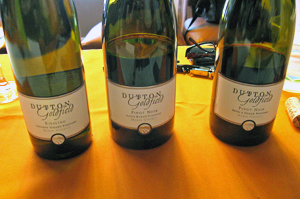 |
Dutton-Goldfield 2013 Riesling, Chileno Valley Vineyard, Marin County. Dry Riesling made entirely in stainless steel with no malolactic fermentation. Light straw color, with floral and stone fruit aromas along with notes of herbs and citrus. Medium-bodied with a viscous yet lively texture and a crisp finish, nice.
Dutton-Goldfield 2012 Pinot Noir, Azaya Ranch, Marin County. From 115, 667, 777, 828, and 2A clones, aged in 45% new French oak. Medium ruby color, showing black cherry, tea leaf, spice, and sweet oak on the nose. Medium weight on the palate, finishing with moderate tannins.
Dutton-Goldfield 2012 Pinot Noir, Devil’s Gulch Ranch, Marin County. Aged in 45% new French oak. Medium color, this displayed bigger spice and oak aromas along with red fruit and earth. Richer mouthfeel but with fine acidity and firm tannins on the finish.
Comments: Dutton-Goldfield has one of the longest track records for making wine from Marin County fruit, and Dan Goldfield’s Pinots from Devil’s Gulch Ranch helped put Marin County wines on the map. The 2012 Azaya Ranch Pinot is a new bottling for the winery. The 2013 Riesling is the second one that Dutton-Goldfield has made from Chileno Valley fruit, and unlike the slightly sweet 2011 version, this was seemed quite dry.
Ernest Bloom
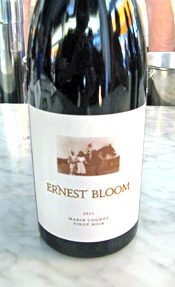 |
Ernest Bloom 2012 Pinot Noir, Chileno Valley Vineyard, Marin County. Medium-light ruby color, with plummy fruit along with earth, spice, and undertones of sweet oak. Medium-bodied with bright acidity on the palate and moderate tannins.
Ernest Bloom 2010 Pinot Noir, Marin County. Medium-light color, the earthy component was more prominent, along with tea leaf, black cherry, and spice on the nose. Medium weight with a firm tannic finish.
Ernest Bloom 2011 Pinot Noir, Marin County. Sourced from just one ton of fruit, aged in 50% new oak. Slightly lighter color, featuring a bright aromas with a savory/herbal character, along with earth, spice, red fruits, and a touch of vanilla/oak. Medium-bodied with vibrant acidity and moderate tannins on the long and lively finish, nice.
Ernest Bloom 2011 Pinot Noir, Carneros. Sourced from the noted Ferguson Block, source of many Robert Stemmler Pinots. Medium-light ruby color, this showed earth and forest floor notes upfront, with red fruit and spice in support. Less bright in the mouth than the Marin bottling, with a richer texture and smoother finish.
Comments: Ernest Bloom is a newcomer to this event, but the winery owner is certainly well-known – Anne Moller-Racke, famed for her work at Donum Estate. The fruit for the Marin Pinots was all sourced from Chileno Valley (Corda) Vineyard, and it was all entirely destemmed except a little whole-cluster fermentation in 2012.
 |
|
Easkoot Cellars
 |
Foggy Bottom 2012 Pinot Noir, Sonoma Coast. Sourced from three Sonoma Coast vineyards, aged in older oak. Lighter color, with savory/herbal aromas plus red fruits and a chalky mineral note. Medium-bodied and lively, with moderate tannins, nice.
Easkoot 2012 Pinot Noir, Chileno Valley Vineyard, Marin County. 30% whole-cluster fermentation. Lighter color, with herbs, black cherry, and lots of spice on the nose. Medium weight and fairly smooth on the palate, with refined tannins on the finish.
Easkoot 2011 Pinot Noir, Chileno Valley Vineyard, Marin County. From three Pinot clones, made with about 20% whole-cluster fermentation and aged in 20% new French oak. Medium-light color, with strawberry, spice, and forest floor aromas, with touches of flowers and sweet oak. Medium-bodied with good structure and chalky tannins – nice now, but could use more time in the bottle to reach its potential.
Easkoot 2009 Pinot Noir, Marin County. Sourced from Chileno Valley Vineyard, fermented with about 10% whole clusters. Medium ruby color, with bright red fruits, herbs, and undertones of vanilla/oak on the nose. Lively acidity in the mouth, with fine tannins on the finish, developing nicely.
Comments: Easkoot’s first vintage of Marin Pinot was from 2009, and owners Stephan Schindler and Emily Schindler Weissman also own Winemonger, an import business. The Foggy Bottom line is for more value-oriented bottlings. (Disclosure – I helped bottle the 2009 Pinot).
Kendric Vineyards
Kendric 2013 Viognier, Marin County. Made entirely in stainless steel, with extended skin contact for about 15% of the fruit. Light straw color, featuring stone fruit and tropical fruit aromas, with touches of flowers, citrus, and fresh herbs. Medium-light bodied, with a slightly chalky quality on the long finish, nice.
Kendric 2010 Pinot Noir, Marin County. About 67% whole-cluster fermentation. Lighter ruby color, with cherry and raspberry fruit, spice, and tea leaf plus undertones of sweet oak. Medium-bodied with good structure and vibrant acidity, finishing with moderate tannins – could still use more time in the cellar but tasty now.
Kendric 2009 Pinot Noir, Marin County. About 67% whole-cluster fermentation. Medium-light color, this had riper and slightly higher-toned red fruit aromas, along with more spice than the 2010. Medium weight on the palate with a lively texture and firm finish.
Kendric 2012 Pinot Noir, “Reserve,” Marin County (barrel sample). 50% new oak. Lighter garnet color, displaying bright cherry fruit, with spice and vanilla/oak components in support. Bigger, richer mouthfeel than the previous two wines, with grippier tannins – still developing and clearly in need of more time.
Kendric 2005 Pinot Noir, Marin County. Medium-light garnet color, this had ripe black cherry fruit and spice aromas, along with tea leaf and earth. Medium-bodied with moderate acidity and still firm tannins.
Kendric 2004 Pinot Noir, Marin County. First vintage from the vineyard. Medium-light garnet, showing earth, slightly tart red cherry, and herbs on the nose. Medium weight on the palate with a fairly smooth mouthfeel and finish.
Comments: Stewart Johnson’s estate vineyard, on the northern edge of Marin, is planted mostly to seven clones of Pinot Noir. In recent vintages, Stewart has worked with more whole-cluster fermentations and longer macerations. He always brings some older vintages of his Pinot to compare with the current release. Kendric’s first Viognier was from the 2012 vintage, sourced from a small part of the estate vineyard grafted to that variety in 2011. (Disclosure – I helped bottle the 2013 Viognier).
McEvoy Ranch Winery
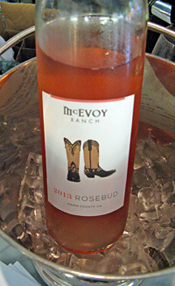 |
McEvoy Ranch 2013 Rosé, “Rosebud,” Estate, Marin County. Made by both whole-cluster press and saignée, mostly from Pinot Noir and Syrah, plus some Grenache, Montepulciano, and Refosco. Light salmon/pink color, this featured bright fresh strawberry and floral aromas, with herbal undertones. Medium-light bodied with vibrant acidity and a clean, crisp finish, nice.
McEvoy Ranch 2011 Pinot Noir, “Evening Standard,” Estate, Marin County. Sourced from 115, 777, Calera, Swan, and Pommard clones from McEvoy Ranch and 828 and 2A clones from Azaya Ranch. Medium-light ruby color, with tea leaf, red cherry, and earth on the nose. Medium weight on the palate with a smoother texture and fairly mild tannins.
McEvoy Ranch 2010, “Red Piano,” North Coast. All estate fruit, mostly Syrah, along with Montepulciano, Alicante Bouschet, Refosco, Grenache, Mourvèdre, Barbera, and Viognier. Medium-dark color, showing a savory character plus darker fruit, spice, and a touch of black pepper. Medium-full bodied, finishing with big, grippy tannins.
Comments: Long-known for their fine olive oil, McEvoy Ranch planted about 8-1/2 acres of their land with grapevines in 2006, starting with Pinot Noir, Syrah, Montepulciano, Grenache, Viognier, Alicante Bouschet, and Refosco. Since 2012, McEvoy Ranch has also taken over farming 19 acres of vines at Azaya Ranch. The wines are made at their home ranch, and Margaret Koski-Kent heads up the winemaking team.
Pacheco Ranch Winery
Pacheco Ranch 2005 Cabernet Sauvignon, Estate, Marin County. Medium purple color, this displayed savory/herbal aromas upfront, with plummy fruit, earth, green olives, and black pepper in support. Medium-bodied with lively acidity and firm tannins, nice.
Pacheco Ranch 2006 Cabernet Sauvignon, Estate, Marin County. Medium color, with a more fruit-forward character than the previous wine, showing ripe black cherry and plum along with earth and spice notes. Bigger and more structured on the palate, with a chewy tannic finish.
Pacheco Ranch 2006 Cabernet Sauvignon, “Reserve,” Estate, Marin County. Sourced from specific vineyard blocks (mostly hillsides), aged in 50% each French and American oak. Medium purple, with more intense ripe plum and currant fruit along with a bigger vanilla/oak component, supported by earth and spice. Richer mouthfeel than the previous wine but retaining good acidity, this finished with very grippy tannins.
Comments: Founded in 1973, Pacheco Ranch is the oldest winery in Marin – the estate vineyard was first planted in 1969. They’re located in the warmer eastern side of the county near Novato, and specialize in Cabernet Sauvignon from their dry-farmed estate vineyard. The wines are typically aged two to three years in barrel and another two in bottle prior to release. The Cabs are a bit rustic and in a lighter style than most from California.
Pey-Marin Vineyards
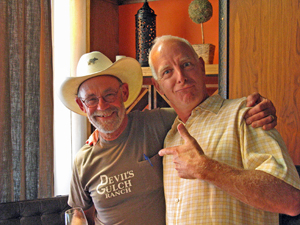 |
| Mark Pasternak of Devil's Gulch Ranch with Jonathan Pey of Pey-Marin |
Pey-Marin 2006 “The Shell Mound” Riesling, Marin County. Dry Riesling made entirely in stainless steel with no malolactic fermentation, 11% alcohol. Very light straw color, this featured petrol and stone fruit aromas along with touches of herbs and flowers. Medium weight on the palate with a lively texture and a chalky mineral note on the finish – developing very well in the bottle
Pey-Marin 2013 “The Shell Mound” Riesling, Marin County. A dry Riesling cold-fermented and aged mostly in stainless steel plus a little neutral oak, with no malolactic fermentation, bottled a little over a month prior to the tasting. Very light straw color, with bright stone fruit, flowers, and herbs on the nose, plus a stony mineral note. Moderately rich but with vibrant acidity, the mineral component returned on the long finish, nice.
Pey-Marin 2006 “Trois Filles” Pinot Noir, Marin County. Sourced from three vineyards, using nine clones, aged 14 months in about 25% new oak. Medium-light garnet color, displaying red fruits, earth, and forest floor scents plus undertones of spice and sweet oak. Medium-bodied and still lively, with fine tannins on the finish.
Comments: Pey-Marin’s Riesling has consistently been a favorite, a very fine and distinctive California Riesling that’s as dry as they come. The most recent release of their “Trois Filles” Marin Pinot was already sold out, so they brought out a library wine to pour at the event. It was a treat to taste the older vintage of their Riesling as well.
Skywalker Vineyards
 |
Viandante del Cielo 2012 Chardonnay, Skywalker Ranch, Marin County. Fermented in stainless steel and aged in oak. Light straw color, with upfront stone fruit aromas along with fresh herbs and a slight floral note. Lighter-bodied with fresh acidity and a long, clean finish, nice.
Viandante del Cielo 2011 Pinot Noir, Skywalker Ranch, Marin County. From clones 115, 667, 777, and 828, aged in 30% new oak. Medium ruby color, this featured ripe black cherry, spice, and vanilla/oak on the nose. Medium-rich texture with good structure, finishing with moderate tannins.
Skywalker 2011 Pinot Noir, Skywalker Ranch, Marin County. From clones 115, 667, 777, and 828, aged in 30% new oak. Medium color, showing more intense ripe black cherry, earth, spice and sweet oak aromas. Bigger and bolder on the palate than the previous wine, with a firmer tannic finish that will take some time in the cellar to smooth out.
Comments: Beginning in 2003, 26 acres of estate Chardonnay & Pinot Noir vines were planted in the hills just west of Nicasio. The Viandante del Cielo (essentially Skywalker in Italian) label is for the more basic wines from Skywalker Ranch, while selected barrels are reserved for the Skywalker label. While they’re generally on the bigger side for Marin wines, they are consistently high-quality and tasty. Scott McLeod is the winemaker. Skywalker Ranch also now produces olive oil.
|



